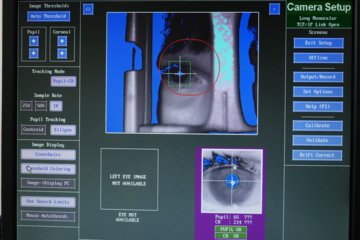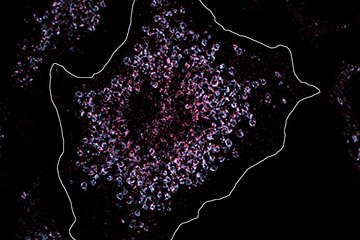Shining a spotlight on the machinery of life
Using a plasmonic nanosensor, it is possible to observe enzymes and how they move without a marker
Researchers from the Max Planck Institute for the Science of Light in Erlangen have developed a technique for directly observing how enzymes and other biomolecules go about their work, with potentially significant medical and scientific benefits. Using this technique, they have, for the first time with just light and without a marker, observed conformational changes in DNA polymerase, the enzyme responsible for replicating DNA. Because the technique can also be used to study how enzymes go about their work, it could help to identify new mechanisms for drug development.

When biologists look through a modern microscope, what they see is a bit like what you might see if you were to look along a highway at night: vehicles are visible only by their headlights and it is impossible to tell whether the headlights belong to a car or a lorry, or whether a parked car is opening its door. At present, biologists can only observe enzymes going about their work indirectly. They attach fluorescent dyes to individual components of biomolecules and then watch the points of light moving about under a microscope. They can see very little of how the shape of the enzyme is changing. In addition, having a dye molecule attached to it means that the enzyme they are watching is not in its natural state. It cannot be ruled out that such dye molecules can affect the enzyme’s function.
A team of researchers headed by Frank Vollmer, until recently the leader of a Research Group at the Max Planck Institute for the Science of Light and now a professor at the University of Exeter, has, however, developed a technique to enable them to observe enzymes without attaching a fluorescent marker.
A nanorod concentrates light on an area of just a few nanometres
Their microscopically-small instrument is effectively a sensor on a sensor. A gold nanorod around 10 nanometres in diameter and 40 nanometres long is attached to a glass microbead with a diameter of about 80 micrometres (1 micrometre = 1/1000 millimetre). A light wave, produced by a laser, is sent skittering around the inside edge of this microbead. Because this wave overlaps the edge of the microbead very slightly, it interacts with the attached nanorod.
This interaction starts out quite weak, but the microbead acts like a whispering gallery: In a rotunda, a word whispered along the wall can be clearly heard on the other side, because the sound wave follows the curve of the wall rather than being dispersed in all directions. In the same way, the light wave going round and round the inside of the microbead passes the gold nanorod thousands of times in an extremely short space of time, amplifying the interaction with the nanorod.
The nanorod draws out the light overlapping the edge of the microbead further. The result is a concentrated area of light like a spotlight approximately the same size as the rod, i.e. just a few nanometres in diameter. If an enzyme or other molecule then binds to the gold nanorod, it is bathed in this spotlight. The signal the sensor produces depends on the molecule positioned in the spotlight and how it moves within this light. This allows the researchers to investigate and record the movements of a single enzyme molecule.
Different signals for different enzyme conformations
The technique is based on a phenomenon known as plasmonics. Applied to tiny metal structures such as nanorods, plasmonics allows light to be concentrated on an area of just a few nanometres. “This allows us to scale the light down to the size of an enzyme,” explains Frank Vollmer from the Max Planck Institute for the Science of Light in Erlangen. And even further – the researchers in Erlangen have even succeeded in using their technique to probe individual ions.

Lending a hand: The sensor is able to detect when a DNA polymerase molecule binds to the gold nanorod of a plasmonic nanosensor and synthesises a DNA strand. During this process the enzyme opens and closes like a hand, changing the extent to which it overlaps with the light spot on the gold nanorod. This changes the wavelength of the light zooming around the inside of the microbead. The researchers use this change in wavelength as a measure of the extent of the overlap.
In one experiment, the physicists attached the enzyme DNA polymerase to their sensor and then tried to record how it moves. DNA polymerase resembles a hand gripping a pipe – the pipe in this case being the DNA strand it is processing. This “hand” produces a different signal when it is open and when it is closed, as this changes the size of the overlap between the light spot and the enzyme. This has allowed the researchers to record how the enzyme opens and closes in real time. “Further refinement of our technique should allow us to do things like directly record synthesis of a DNA strand by the polymerase enzyme,” explains Vollmer. Biochemists would then be able to observe in real time how the enzyme copies genetic information and even use the signal produced by the nanosensor for DNA sequencing.
Experiments using the new technique have been able to observe more than just how enzymes move. “We’ve used it to observe the temperature dependence of enzyme activity,” explains Frank Vollmer. This offers an easy way of performing thermodynamic studies. Such studies can provide information on characteristics such as the activation energy of an enzyme, the physicist explains. The activation energy is a measure of the efficiency of these biological catalysts.
The nanosensor can be used to observe chemical reactions

To demonstrate just how small the particles that can be detected using a plasmonic nanosensor can be, the researchers used it to observe individual ions (electrically charged atoms). “We were surprised that this was even possible,” says Vollmer. The zinc and mercury ions they used are only around a tenth of a nanometre in size – less than a thousandth of the wavelength of the light used. It is, however, possible to produce a light spot at the end of a nanorod which is able to probe such tiny dimensions. “It’s not about identifying individual ions,” stresses Vollmer. The researchers were able to ensure that exactly one ion attached itself to the end of the nanorod by varying the concentration of ions in solution. Getting down to this scale could allow biologists to study ion channel function. Ion channels include, for example, proteins embedded in nerve cell membranes which are responsible for signal transmission along the nerve.
Use of the nanosensor developed by Frank Vollmer’s team is not limited to visualising biochemical processes involving enzymes and other proteins. It can also be used to observe chemical reactions between individual molecules and the surface of the gold nanorod. “Using this technique, we can, for example, detect and analyze mechanisms of interaction,” explains Frank Vollmer. The time course of these interactions may provide insights into how different molecules bind to the surface of the gold nanorod.
To demonstrate this, the researchers studied two types of molecule, one containing an amine group, one containing a thiol group. “It turns out that the two groups react with the surface of the gold via different mechanisms,” explains Vollmer. Whereas the amine groups bind to gold atoms projecting from the surface, the thiol groups only bind to atoms embedded completely in the surface.

Image: Frank Vollmer/Advanced Materials
The researchers also observed reactions between the various molecules. “This allows chemists to test and optimize reaction conditions in real time,” says Vollmer. Use of this gold nanorod light spot is not limited to studying chemical reactions, however – it can also be used to control them. By increasing the intensity of the light in the concentrated light spot, the researchers enabled a mercury ion to bind to the surface of the gold nanorod. The intensity of the light in the light spot increases the energy of the electrons in the gold rod so that they are able to react with the mercury ions. This produces a stable amalgam of gold and mercury. The two elements remain amalgamated even when the light spot disappears, as the reaction produces a relatively stable covalent bond between a gold atom and a mercury atom.
“Controlling reactions and enzyme activity on the plasmonic biosensor is a very interesting area for future research,” says Vollmer. The light spot can also be used as an optical tweezers to temporarily fix single biomolecules to the sensor for optical analysis.
Insights into malfunctions in the machinery of life
Vollmer’s team’s future vision is to be able to scan molecules – both biomolecules and synthetic molecules – atom by atom. “By using different light sources with different wavelengths and polarizations, it is in principle possible to modify the degree to which the light overlaps the molecule and probe different domains of the same molecule,” explains Vollmer. A molecular scanner of this type might be able to observe a process from a variety of different angles and at very short intervals. A high resolution map of such a process would significantly enhance our understanding of the molecular machinery. Biologists would even be able to observe in detail how such structures change over periods ranging from nanoseconds to several hours. The plasmonic biosensor also raises the possibility of an automated laboratory no larger than a fingernail, which scans a sample, protein by protein, to diagnose disease at the molecular level.
Should it in future become possible to use plasmonic nanosensors to see how enzymes change their shape, this could enable clinicians to better understand how malfunctions in the machinery of life cause diseases such as Alzheimer’s, which are associated with changes in enzyme structure. A better understanding of such processes could even provide new approaches to treatment.















